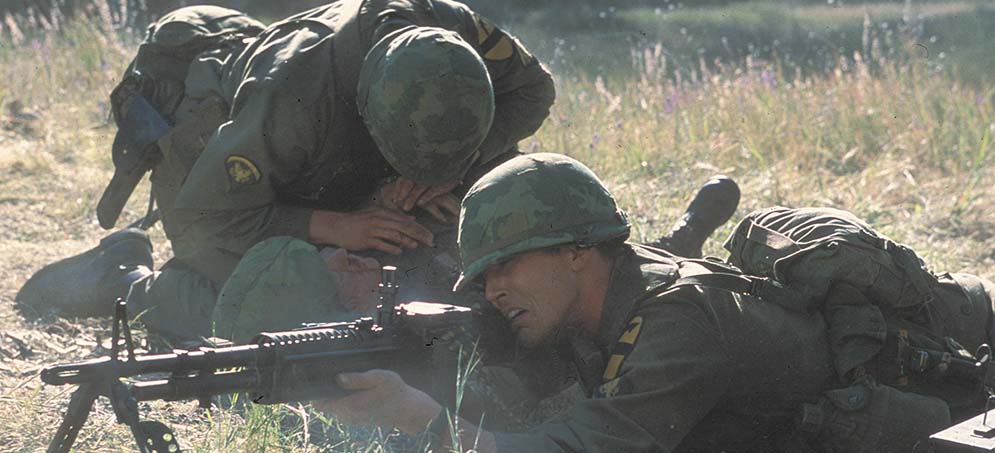Lead Photo: Soldiers of the First Battalion, Seventh Cavalry, in a scene showing the savagery of the battle- as one man performs first aid on a heavily wounded comrade, while another soldier fires the M60 GPMG. The battle was intense, and reports recorded this type of scene over and over as the NVA pressed their attack. Photo: Stephen Vaughan courtesy Paramount Pictures.
By Dan Shea
14 November, 1965. Early in the morning, the soldiers of several companies of the 1st Battalion 7th Cavalry went airmobile and were helicoptered into a remote area of South Vietnam, near the Cambodian border. This was referred to as the Ia Drang Valley, for the river Drang flowed through it. This is near the place where, in 1954, the French Mobile Force 100 had been ambushed by Viet Minh and wiped out. The Cav landed at the base of Chu Pong mountain, which turns out to have been the staging area for a major North Vietnamese Army (NVA) regiment. The initial odds in that morning’s contact were approximately 1600 NVA looking down on 175 Americans. The NVA did not have any heavy weapons, no DSHKs, or things might have been even worse for the Cav. It would be hard to think of a tougher spot to be in, however, than where those brave American soldiers found themselves when they hit LZ X-Ray that morning.
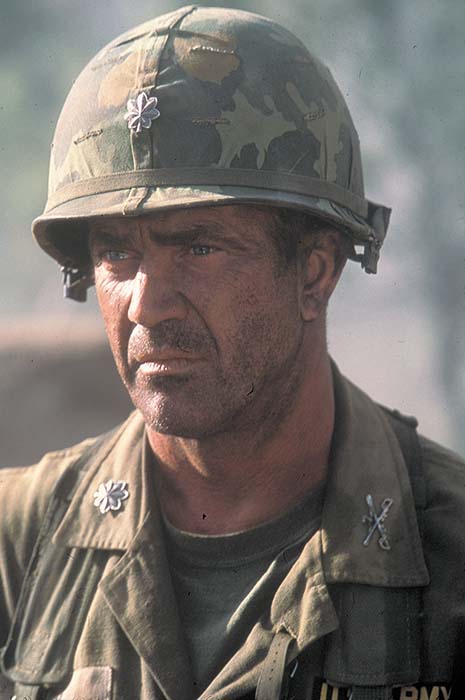
The ensuing battle lasted for three days, and moved to another landing zone, involving different American and North Vietnamese forces. At the end of the battle, there were more than 230 dead American soldiers, and about 268 wounded. The NVA had suffered massive casualties that dwarfed the American losses. It was Kalashnikov’s rifle versus Stoner’s rifle, the new XM16E1 being the issue weapon of the 7th Cav and Chinese manufactured AK47s arming the NVA.
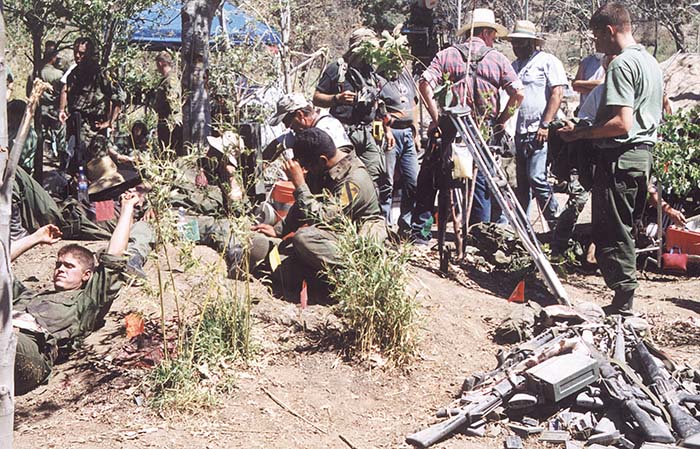
Dan Shea Photo.
Lt. Colonel Moore had been told to “Find the enemy, and fight him”. To go pick a fight. It turns out the commander of the NVA regiment had the same instructions- to find out how the Americans and their new helicopter assault tactics were to fight against. Both sides learned a lot in those few days. President Johnson et al used the results of this battle to massively escalate the US presence in South Vietnam.
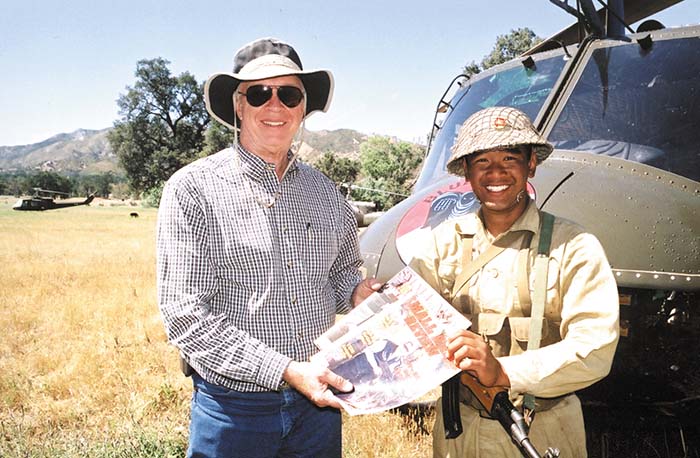
Dan Shea photo.
Lt. Col. Moore retired as a Lt. General in 1977 with 32 years of service. In 1992, Gen Moore and Joe Galloway, a journalist who had been on the ground through the whole fight, put together a book titled “We Were Soldiers, Once, and Young”. SAR has previously done a review of this book. In the book, they chronicled, day by day, hour by hour, the fighting as it developed. It is an incredible story of everyday men, who when placed in harm’s way, persevered and through thousands of instances of heroic sacrifice, prevailed. Every American should read this book.
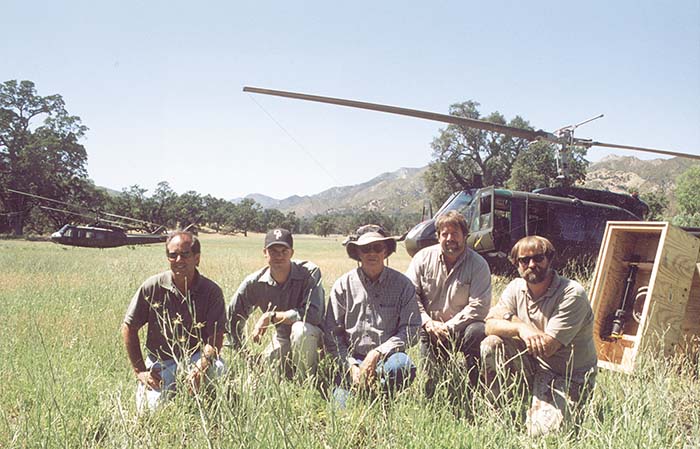
Paramount took on the job of making a movie from the book. The title was changed to “We Were Soldiers”, and the byline of we were fathers, brothers, sons, etc. was added. One of many things about the book that impressed me, was that General Moore and Galloway chose to touch on the families, to show what went on at home, and in the aftermath of the battle. The movie has chosen to follow suit, to present a microcosm of the lives and loved ones of the men who served so valiantly, and their struggles and sacrifices as well. I have not seen the movie yet, but I have been told they stayed true to the book. God Bless them for that. The NVA are represented in the movie as well, to see what they went through as they faced the Americans. I was pleased to hear that as well.
While we were on the set, I took the time to speak with as many of the actors and crew as I could. I was struck by the fact that many were veterans of the US Military, even though many were too young for Vietnam. I did speak with Stan Cockerell, an assistant propmaster, who was working on the set- Stan is a veteran of the 9th Infantry Division in Vietnam- a unit that in the 1965-66 period saw heavy action in the South. This is the same time frame as the Ia Drang fight. Stan had an M16 with an XM148 40mm launcher on it. He took a few moments to talk with me about the weapons he used, and to reflect on the making of this movie. He seemed pleased with the way the movie was being made, with the portrayal of the US Soldiers, with the realism of the uniforms and gear, with the atmosphere being evoked on the set. That was enough for me to instantly become a cheerleader for this movie.
The rental companies that supply firearms to the movies have a demanding job- the guns have to work with blanks- no mean feat in itself, and they have to be correct to the period and war. In this case, Cinema Weaponry in Glendale, California, (Cinema Weaponry has a shared line with Stembridge Gun Rentals- 818-246-4333) was the prime contractor. Mike Papac, a well-known gun handler, is the owner. Mike took great care, and did a tremendous amount of studying to ensure that the weapons and accessories would be correct for both the US and Vietnamese, as well as for the flashback scenes of the French in 1954. We had a number of conversations on the subject as the movie was being prepared, and it was evident that Mike was putting a tremendous effort in tracing the historical use of small arms in the battles. SAR will always be supportive of that!
I can’t write a movie review without having seen it, but the actors that were chosen to portray characters certainly seem appropriate. The taller than life Sergeant Major Basil Plumley is portrayed by Sam Elliot, which led to the “Heart-throb” discussion by the women at SAR. I thought that Mel Gibson would be the heart-throb, but any mention of Sam Elliot, well, the ladies all want to see the movie now. Sorry, Mel.
In essence, I am definitely going to see “We Were Soldiers”. If all the indicators work, this might well be one of the first movies about the Vietnam War that escapes being politicized towards the left, and simply tells the story of brave men, hard times, sacrifice, and honor. How refreshing.- Dan Shea
| This article first appeared in Small Arms Review V5N7 (April 2002) |



